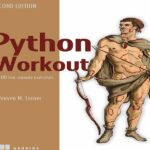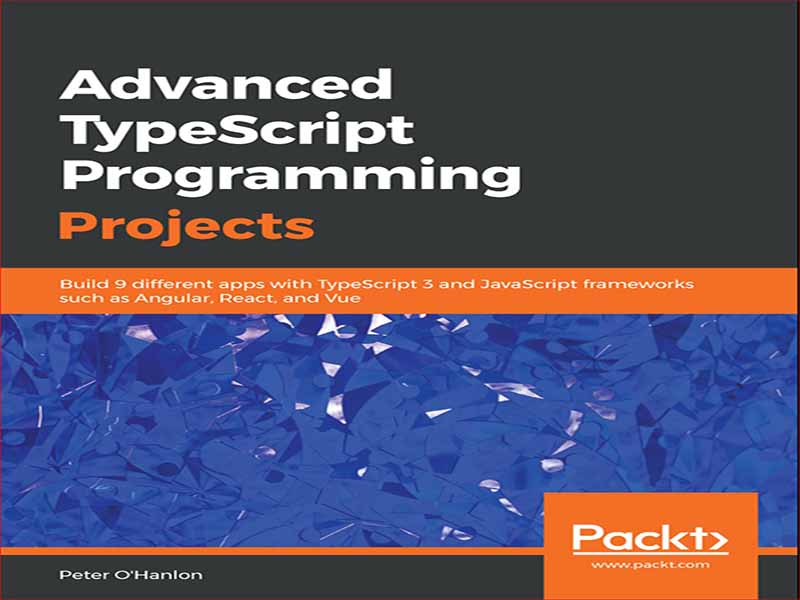- عنوان: Advanced TypeScript Programming Projects
- نویسنده: Peter O’Hanlon
- حوزه: تایپ اسکریپت
- سال انتشار: 2019
- تعداد صفحه: 408
- زبان اصلی: انگلیسی
- نوع فایل: pdf
- حجم فایل: 11.1 مگابایت
این کتاب در مورد TypeScript است. اما دوباره، شما این را از عنوان دریافت کردید. اما این چیزی بیش از یک کتاب در مورد TypeScript است. این کتابی در مورد چگونگی استفاده از TypeScript برای فراتر رفتن از نمونه های اولیه است. این بدان معناست که این کتابی درباره موضوعاتی است که کمی سختتر از آن چیزی است که ممکن است در اولین تلاشهای خود در دنیای TypeScript پوشش داده باشید. بنابراین، احتمالاً میتوانیم جمله آغازین را به صورت «این کتابی است در مورد TypeScript و برخی از راههای سرگرمکننده و جالب که میتوانید از TypeScript با فناوریهایی که پیشرفتهتر از آنهایی که قبلاً استفاده میکردم استفاده کنید» را بازنویسی کنیم. پیشاپیش، من می گویم که این کتاب کتابی در مورد نحوه برنامه نویسی در Angular، React، Vue، یا ASP.NET Core نیست. اینها موضوعات بزرگی هستند که شایسته کتابهای جداگانه خودشان هستند (در واقع، در پایان هر فصل، تمام تلاشم را می کنم تا شما را به منابع دیگری راهنمایی کنم که به شما کمک می کند این فناوری ها را در سطحی بسیار عمیق تر از فصل های کوتاهی که در مورد آن خواهیم داشت یاد بگیرید. آنها). در عوض، برای Angular و React، من سعی میکنم معرفی ویژگیهای جدید را به بیش از پنج مفهوم جدید در هر فصل محدود کنم. در جایی که از فناوری مانند بوت استرپ استفاده می کنیم که پیاده سازی ویژه فناوری دارد، از کتابخانه ای استفاده خواهیم کرد که مناسب ترین است، مانند reactstrap برای React. ما این کار را انجام می دهیم زیرا این کتابخانه ها برای کار با چارچوب رابط کاربری (UI) مورد نظر طراحی شده اند. هنگامی که ما در حال انجام تحقیقات اولیه برای این کتاب بودیم، یکی از سوالاتی که مدام مطرح میشد این بود، “در حال حاضر چه چیز داغی است؟ مردم از چه چیزهای جدید و هیجانانگیزی استفاده میکنند؟” هدف این کتاب معرفی برخی از این فناوریها از جمله GraphQL، میکروسرویسها و یادگیری ماشین است. باز هم، این کتاب نمی تواند همه چیز را در مورد فناوری مربوطه آموزش دهد. کاری که انجام میدهد این است که مقدمهای بر این فناوری ارائه میکند و نشان میدهد که چگونه میتوانیم از قدرت TypeScript برای آسانتر کردن زندگی خود در هنگام توسعه با آن استفاده کنیم. یکی از چیزهایی که با مرور کتاب متوجه خواهیم شد این است که من تمایل دارم به شدت روی برنامه نویسی شی گرا (OOP) تمرکز کنم. ما کلاس های زیادی خواهیم ساخت. دلایل زیادی برای این وجود دارد، اما بزرگترین دلیل این تمرکز این است که در فصل های اولیه، ما قصد داریم کدی بنویسیم که بتوانیم در فصل های بعدی از آن استفاده کنیم. من همچنین میخواستم کدی بنویسم که در صورت تمایل میتوانید آن را در پایگاه کد خود قرار دهید. با TypeScript، توسعه مبتنی بر کلاس این کار را بسیار سادهتر میکند. این همچنین به ما این فرصت را میدهد تا در مورد تکنیکهایی صحبت کنیم که میتوانیم برای سادهتر کردن کد، حتی زمانی که از فناوریهای پیشرفتهتر استفاده میکنیم، استفاده کنیم، بنابراین اصولی مانند کلاسهایی که دارای یک مسئولیت واحد هستند (معروف به الگوی مسئولیت واحد) و مبتنی بر الگو را پوشش میدهیم. توسعه، جایی که ما الگوهای مهندسی نرم افزار شناخته شده را برای مشکلات پیچیده اعمال می کنیم تا راه حل را ساده کنیم. علاوه بر تایپ اسکریپت، ما در بیشتر فصلها به دنبال استفاده از بوت استرپ برای رابط کاربری هستیم. در دو فصل از Angular، ما به استفاده از Angular Material به جای Bootstrap برای چیدمان رابطها نگاه میکنیم، زیرا Material و Angular دست به دست هم میدهند، و اگر در نهایت برنامههای Angular تجاری را توسعه دهید، احتمالاً میخواهید استفاده از مواد فصل اول ما را با ویژگی هایی آشنا می کند که ممکن است قبلاً از آنها استفاده نکرده باشیم، مانند استراحت و پخش کردن، بنابراین در آنجا با عمق بیشتری به آنها خواهیم پرداخت. در فصلهای بعدی، ما از این ویژگیها بهگونهای استفاده خواهیم کرد که باید طبیعی شوند، بنابراین، به جای ایجاد اختلال در جریان کد با فراخوانی یک آیتم خاص، ما تمایل داریم فقط از ویژگیها به گونهای استفاده کنیم که به طبیعت دوم تبدیل شود. . طرف دیگر این است که، با پیشرفت در کتاب، متوجه میشویم که ویژگیهای فصلهای قبلی به طور کلی دوباره مورد بررسی قرار میگیرند، به طوری که ما فقط یک بار کاری را انجام ندهیم و سپس آن را فراموش نکنیم. این کتاب برای افرادی در نظر گرفته شده است که حداقل با اصول اولیه TypeScript راحت هستند. اگر میدانید چگونه از کامپایلر TypeScript، tsc، برای ساخت فایل پیکربندی و کامپایل کد و اصول اولیه مواردی مانند ایمنی نوع، توابع و کلاسها در TypeScript استفاده کنید، پس باید بتوانید چیزی از این کتاب دریافت کنید. . اگر درک پیشرفتهتری از TypeScript دارید، پس باید مطالب زیادی در مورد فناوریهایی که قبلاً از آنها استفاده نکردهاید وجود داشته باشد که مورد توجه قرار گیرد.
This is a book about TypeScript; but then again, you got that from the title. But it’s more than just a book about TypeScript. This is a book about how TypeScript can be used to go beyond basic examples. That means that this is a book about topics that are just that little bit harder than you might already have covered in your first forays into the world of TypeScript. So, we could probably rephrase that opening sentence to “This is a book about TypeScript and some of the fun and cool ways that you can use TypeScript with technologies that are more advanced than ones I’ve been using before”. Upfront, I will say that this book is not a book about how to program in Angular, React, Vue, or ASP.NET Core. Those are big topics that deserve their own separate books (indeed, at the end of each chapter, I do my best to point you toward other resources that will help you learn these technologies on a much deeper level than the brief chapters we will have on them). Instead, for Angular and React, I try to limit the introduction of new features to no more than five new concepts per chapter. Where we are using a technology such as Bootstrap, which has a technology-specific implementation, we will use the library that is most appropriate, such as reactstrap for React. We do this because these libraries have been designed to work with the user interface (UI) framework in question. When we were doing the initial research for this book, one of the questions that kept cropping up was, “what’s hot right now? What are people using that’s new and exciting?” This book aims to offer an introduction to some of those technologies, including GraphQL, microservices, and machine learning. Again, this book cannot teach everything about the relevant technology. What it does do is provide an introduction to the technology and show how we can leverage the power of TypeScript to make our lives so much easier when developing with it. One thing we will find as we go through the book is that I tend to focus on object-oriented programming (OOP) pretty heavily. We will be building a lot of classes. There are many reasons for this, but the biggest reason for this focus is that in early chapters, we are going to be writing code that we can make use of in later chapters. I also wanted to write code that you could just drop into your own code base if you wanted to. With TypeScript, classbased development makes this make this so much simpler. This also gives us the opportunity to talk about techniques that we can apply to make code simpler, even when using more advanced technologies, so we cover principles such as classes having a single responsibility (known as the Single Responsibility Pattern), and pattern-based development, where we apply well-known software engineering patterns to complex problems to make the solution simple. As well as TypeScript, we are going to be looking at using Bootstrap for the UI for most of the chapters. In the couple of chapters on Angular, we do look at using Angular Material instead of Bootstrap for laying out interfaces, because Material and Angular go hand in hand, and if you end up developing commercial Angular applications, then chances are that you are going to use Material. The first chapter introduces us to features that we might not have used before, such as rest and spread, so we will cover them in more depth there. In later chapters, we will be using these features in a way that should become natural, so, rather than disturbing the flow of the code by calling out a particular item, we will tend to just use the features in a way that becomes second nature. The other side to this is that, as we progress through the book, we will find that features from earlier chapters will generally be touched on again, so that we don’t just do something once and then forget about it. This book is intended for people who are comfortable with at least the basics of TypeScript. If you know how to use the TypeScript Compiler, tsc, to build a config file and compile code, and the basics of things such as type safety, functions, and classes in TypeScript, then you should be able to get something out of this book. If you have a more advanced understanding of TypeScript, then there should be plenty of material on technologies that you’ve not used before that will be of interest.
این کتاب را میتوانید بصورت رایگان از لینک زیر دانلود نمایید.
Download: Advanced TypeScript Programming Projects




































نظرات کاربران